Zhe Cui
FingerSplat: Contactless Fingerprint 3D Reconstruction and Generation based on 3D Gaussian Splatting
Sep 19, 2025Abstract:Researchers have conducted many pioneer researches on contactless fingerprints, yet the performance of contactless fingerprint recognition still lags behind contact-based methods primary due to the insufficient contactless fingerprint data with pose variations and lack of the usage of implicit 3D fingerprint representations. In this paper, we introduce a novel contactless fingerprint 3D registration, reconstruction and generation framework by integrating 3D Gaussian Splatting, with the goal of offering a new paradigm for contactless fingerprint recognition that integrates 3D fingerprint reconstruction and generation. To our knowledge, this is the first work to apply 3D Gaussian Splatting to the field of fingerprint recognition, and the first to achieve effective 3D registration and complete reconstruction of contactless fingerprints with sparse input images and without requiring camera parameters information. Experiments on 3D fingerprint registration, reconstruction, and generation prove that our method can accurately align and reconstruct 3D fingerprints from 2D images, and sequentially generates high-quality contactless fingerprints from 3D model, thus increasing the performances for contactless fingerprint recognition.
A Transformer-based Multimodal Fusion Model for Efficient Crowd Counting Using Visual and Wireless Signals
Apr 28, 2025Abstract:Current crowd-counting models often rely on single-modal inputs, such as visual images or wireless signal data, which can result in significant information loss and suboptimal recognition performance. To address these shortcomings, we propose TransFusion, a novel multimodal fusion-based crowd-counting model that integrates Channel State Information (CSI) with image data. By leveraging the powerful capabilities of Transformer networks, TransFusion effectively combines these two distinct data modalities, enabling the capture of comprehensive global contextual information that is critical for accurate crowd estimation. However, while transformers are well capable of capturing global features, they potentially fail to identify finer-grained, local details essential for precise crowd counting. To mitigate this, we incorporate Convolutional Neural Networks (CNNs) into the model architecture, enhancing its ability to extract detailed local features that complement the global context provided by the Transformer. Extensive experimental evaluations demonstrate that TransFusion achieves high accuracy with minimal counting errors while maintaining superior efficiency.
ProFi-Net: Prototype-based Feature Attention with Curriculum Augmentation for WiFi-based Gesture Recognition
Apr 28, 2025Abstract:This paper presents ProFi-Net, a novel few-shot learning framework for WiFi-based gesture recognition that overcomes the challenges of limited training data and sparse feature representations. ProFi-Net employs a prototype-based metric learning architecture enhanced with a feature-level attention mechanism, which dynamically refines the Euclidean distance by emphasizing the most discriminative feature dimensions. Additionally, our approach introduces a curriculum-inspired data augmentation strategy exclusively on the query set. By progressively incorporating Gaussian noise of increasing magnitude, the model is exposed to a broader range of challenging variations, thereby improving its generalization and robustness to overfitting. Extensive experiments conducted across diverse real-world environments demonstrate that ProFi-Net significantly outperforms conventional prototype networks and other state-of-the-art few-shot learning methods in terms of classification accuracy and training efficiency.
Boosting Self-Efficacy and Performance of Large Language Models via Verbal Efficacy Stimulations
Feb 10, 2025Abstract:Significant improvements have been observed in the zero-shot capabilities of the Large Language Models (LLMs). Due to their high sensitivity to input, research has increasingly focused on enhancing LLMs' performance via direct and simple prompt engineering rather than intricate domain adaptation. Studies suggest that LLMs exhibit emotional intelligence, and both positive and negative emotions can potentially enhance task performances. However, prior interaction prompts have predominantly concentrated on a single stimulus type, neglecting to compare different stimulus effects, examine the influence of varying task difficulties, or explore underlying mechanisms. This paper, inspired by the positive correlation between self-efficacy and task performance within the social cognitive theory, introduces Verbal Efficacy Stimulations (VES). Our VES comprises three types of verbal prompts: encouraging, provocative, and critical, addressing six aspects such as helpfulness and competence. And we further categorize task difficulty, aiming to extensively investigate how distinct VES influence the self-efficacy and task achievements of language models at varied levels of difficulty. The experimental results show that the three types of VES improve the performance of LLMs on most tasks, and the most effective VES varies for different models. In extensive experiments, we have obtained some findings consistent with psychological theories, providing novel insights for future research.
Contactless Fingerprint Recognition Using 3D Graph Matching
Sep 13, 2024Abstract:Contactless fingerprint is a newly developed type of fingerprint, and has gained lots of attention in recent fingerprint studies. However, most existing contactless fingerprint algorithms treat contactless fingerprints as 2D plain fingerprints, and utilize similar recognition methods as traditional contact-based 2D fingerprints. This recognition approach does not consider the modality difference between contactless and contact fingerprints, especially the intrinsic 3D characteristic of contactless fingerprints. This paper proposes a novel contactless fingerprint recognition algorithm that captures the revealed 3D feature of contactless fingerprints rather than the plain 2D feature. The proposed method first recovers 3D features from the input contactless fingerprint, including the 3D shape model and 3D fingerprint feature (minutiae, orientation, etc.). Then, a novel 3D graph matching is conducted in 3D space according to the extracted 3D feature. Our method captures the real 3D nature of contactless fingerprints as the whole feature extraction and matching algorithms are completed in real 3D space. Experiments results on contactless fingerprint databases show that the proposed method successfully improves the matching accuracy of contactless fingerprints. Exceptionally, our method performs stably across multiple poses of contactless fingerprints due to 3D graph matching, which is a great advantage compared to previous contactless fingerprint recognition algorithms.
Securing FC-RIS and UAV Empowered Multiuser Communications Against a Randomly Flying Eavesdropper
Aug 26, 2024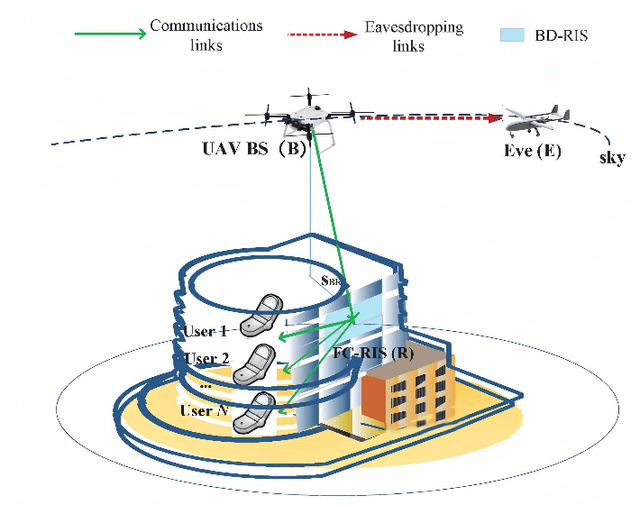

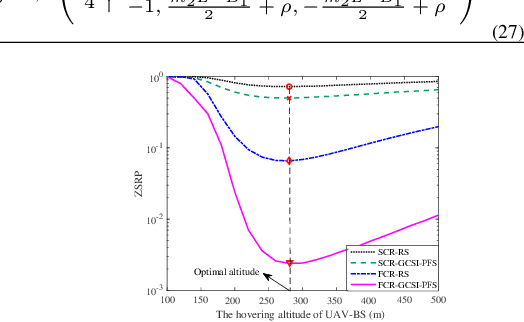
Abstract:This paper investigates a wireless network consisting of an unmanned aerial vehicle (UAV) base station (BS), a fully-connected reconfigurable intelligent surface (FC-RIS), and multiple users, where the downlink signal can simultaneously be captured by an aerial eavesdropper at a random location. To improve the physical-layer security (PLS) of the considered downlink multiuser communications, we propose the fully-connected reconfigurable intelligent surface aided round-robin scheduling (FCR-RS) and the FC-RIS and ground channel state information (CSI) aided proportional fair scheduling (FCR-GCSI-PFS) schemes. Thereafter, we derive closed-form expressions of the zero secrecy rate probability (ZSRP). Numerical results not only validate the closed-form ZSRP analysis, but also verify that the proposed GCSI-PFS scheme obtains the same performance gain as the full-CSI-aided PFS in FC-RIS-aided communications. Furthermore, optimizing the hovering altitude remarkably enhances the PLS of the FC-RIS and UAV empowered multiuser communications.
MLS-Track: Multilevel Semantic Interaction in RMOT
Apr 18, 2024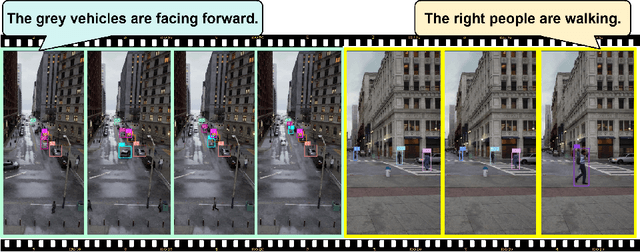

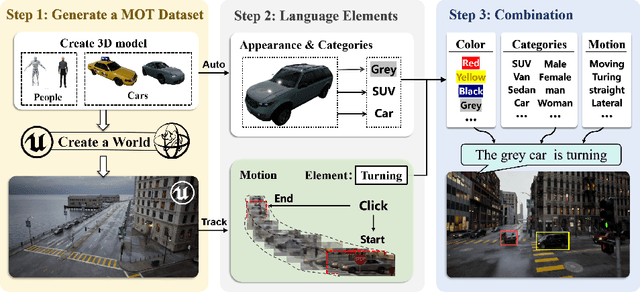
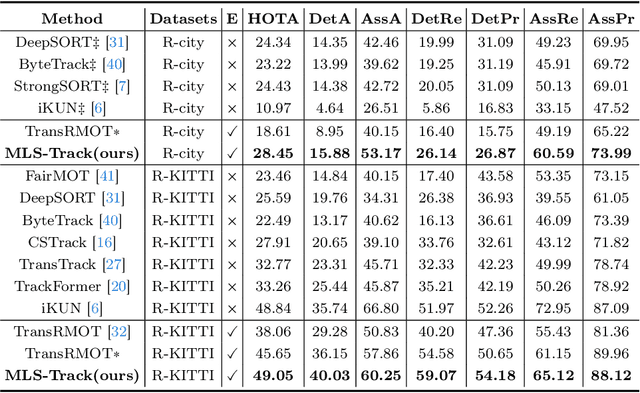
Abstract:The new trend in multi-object tracking task is to track objects of interest using natural language. However, the scarcity of paired prompt-instance data hinders its progress. To address this challenge, we propose a high-quality yet low-cost data generation method base on Unreal Engine 5 and construct a brand-new benchmark dataset, named Refer-UE-City, which primarily includes scenes from intersection surveillance videos, detailing the appearance and actions of people and vehicles. Specifically, it provides 14 videos with a total of 714 expressions, and is comparable in scale to the Refer-KITTI dataset. Additionally, we propose a multi-level semantic-guided multi-object framework called MLS-Track, where the interaction between the model and text is enhanced layer by layer through the introduction of Semantic Guidance Module (SGM) and Semantic Correlation Branch (SCB). Extensive experiments on Refer-UE-City and Refer-KITTI datasets demonstrate the effectiveness of our proposed framework and it achieves state-of-the-art performance. Code and datatsets will be available.
AVM-SLAM: Semantic Visual SLAM with Multi-Sensor Fusion in a Bird's Eye View for Automated Valet Parking
Sep 15, 2023Abstract:Automated Valet Parking (AVP) requires precise localization in challenging garage conditions, including poor lighting, sparse textures, repetitive structures, dynamic scenes, and the absence of Global Positioning System (GPS) signals, which often pose problems for conventional localization methods. To address these adversities, we present AVM-SLAM, a semantic visual SLAM framework with multi-sensor fusion in a Bird's Eye View (BEV). Our framework integrates four fisheye cameras, four wheel encoders, and an Inertial Measurement Unit (IMU). The fisheye cameras form an Around View Monitor (AVM) subsystem, generating BEV images. Convolutional Neural Networks (CNNs) extract semantic features from these images, aiding in mapping and localization tasks. These semantic features provide long-term stability and perspective invariance, effectively mitigating environmental challenges. Additionally, data fusion from wheel encoders and IMU enhances system robustness by improving motion estimation and reducing drift. To validate AVM-SLAM's efficacy and robustness, we provide a large-scale, high-resolution underground garage dataset, available at https://github.com/yale-cv/avm-slam. This dataset enables researchers to further explore and assess AVM-SLAM in similar environments.
Monocular 3D Fingerprint Reconstruction and Unwarping
May 02, 2022



Abstract:Compared with contact-based fingerprint acquisition techniques, contactless acquisition has the advantages of less skin distortion, larger fingerprint area, and hygienic acquisition. However, perspective distortion is a challenge in contactless fingerprint recognition, which changes ridge orientation, frequency, and minutiae location, and thus causes degraded recognition accuracy. We propose a learning based shape from texture algorithm to reconstruct a 3D finger shape from a single image and unwarp the raw image to suppress perspective distortion. Experimental results on contactless fingerprint databases show that the proposed method has high 3D reconstruction accuracy. Matching experiments on contactless-contact and contactless-contactless matching prove that the proposed method improves matching accuracy.
Multi-similarity based Hyperrelation Network for few-shot segmentation
Mar 23, 2022


Abstract:Few-shot semantic segmentation aims at recognizing the object regions of unseen categories with only a few annotated examples as supervision. The key to few-shot segmentation is to establish a robust semantic relationship between the support and query images and to prevent overfitting. In this paper, we propose an effective Multi-similarity Hyperrelation Network (MSHNet) to tackle the few-shot semantic segmentation problem. In MSHNet, we propose a new Generative Prototype Similarity (GPS), which together with cosine similarity can establish a strong semantic relation between the support and query images. The locally generated prototype similarity based on global feature is logically complementary to the global cosine similarity based on local feature, and the relationship between the query image and the supported image can be expressed more comprehensively by using the two similarities simultaneously. In addition, we propose a Symmetric Merging Block (SMB) in MSHNet to efficiently merge multi-layer, multi-shot and multi-similarity hyperrelational features. MSHNet is built on the basis of similarity rather than specific category features, which can achieve more general unity and effectively reduce overfitting. On two benchmark semantic segmentation datasets Pascal-5i and COCO-20i, MSHNet achieves new state-of-the-art performances on 1-shot and 5-shot semantic segmentation tasks.
 Add to Chrome
Add to Chrome Add to Firefox
Add to Firefox Add to Edge
Add to Edge